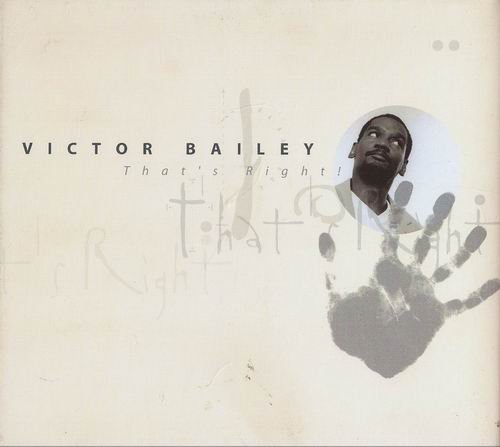
Victor Bailey - That's Right! (2002)
BAND/ARTIST: Victor Bailey
- Title: That's Right!
- Year Of Release: 20002
- Label: Esc Records[ESC/EFA 03676-2]
- Genre: Jazz, Fusion
- Quality: FLAC (image + .cue,log,scans) | MP3/320 kbps
- Total Time: 50:17
- Total Size: 324 MB(+3%) | 119 MB(+3%)
- WebSite: Album Preview
Tracklist
1. Goose Bumps
2. Knee Deep-One Nation Medley
3. Where's Paco?
4. Joey
5. Nothing But Net
6. Rope-A-Dope
7. Steamy
8. Black on the Bach
9. That's Right!
personnel :
Victor Bailey: Bass, Keyboards, Vocals
Omar Hakim: Drums
Lenny White: Drums
Bill Evans: Tenor,Soprano Saxophone
Bennie Maupin: Saxophone, Bass Clarinet
Dean BRown: Guitar
Jim Beard: Keyboards
Very few improvisers would be able to find the jazz potential in two Funkadelic classics, but, in fact, that is among the things that Victor Bailey does on his third album, That's Right! One of the nine tracks on this excellent CD is a medley of "(Not Just) Knee Deep" and "One Nation Under a Groove"; Bailey doesn't approach the late 1970s hits as vocal-oriented p-funk, but rather, as instrumental jazz fusion -- and it works. While those who don't comprehend jazz might prefer to stick to Funkadelic's original versions, fusion heads will understand exactly where the electric bassist is coming from. And they will also find a lot to admire about the album's original material, which ranges from the plaintive "Joey" (a tune that Bailey wrote in memory of a cousin who was killed in a robbery in Philadelphia) to the funky "Goose Bumps" and the clever "Black on the Bach." The latter manages to be influenced by funk and classical at the same time, and Bailey -- much to his credit -- manages to pull this off without sounding silly or pretentious. But then, anyone who is capable of taking two Funkadelic hits and changing them from vocal-oriented p-funk to instrumental fusion obviously knows how to come up with ambitious ideas and make them work. The Funkadelic medley tells you a lot about Bailey. It tells you that although he has a jazz improviser's mentality, he is far from a jazz snob. It tells you that he is someone who, like most fusionists, holds jazz, rock, and funk in equally high regard and realizes that improvisers can learn and benefit from a variety of music. Bailey does exactly that on this 2001 date, which is recommended to anyone who has a taste for meaty, intelligent fusion.~Alex Henderson
1. Goose Bumps
2. Knee Deep-One Nation Medley
3. Where's Paco?
4. Joey
5. Nothing But Net
6. Rope-A-Dope
7. Steamy
8. Black on the Bach
9. That's Right!
personnel :
Victor Bailey: Bass, Keyboards, Vocals
Omar Hakim: Drums
Lenny White: Drums
Bill Evans: Tenor,Soprano Saxophone
Bennie Maupin: Saxophone, Bass Clarinet
Dean BRown: Guitar
Jim Beard: Keyboards
Very few improvisers would be able to find the jazz potential in two Funkadelic classics, but, in fact, that is among the things that Victor Bailey does on his third album, That's Right! One of the nine tracks on this excellent CD is a medley of "(Not Just) Knee Deep" and "One Nation Under a Groove"; Bailey doesn't approach the late 1970s hits as vocal-oriented p-funk, but rather, as instrumental jazz fusion -- and it works. While those who don't comprehend jazz might prefer to stick to Funkadelic's original versions, fusion heads will understand exactly where the electric bassist is coming from. And they will also find a lot to admire about the album's original material, which ranges from the plaintive "Joey" (a tune that Bailey wrote in memory of a cousin who was killed in a robbery in Philadelphia) to the funky "Goose Bumps" and the clever "Black on the Bach." The latter manages to be influenced by funk and classical at the same time, and Bailey -- much to his credit -- manages to pull this off without sounding silly or pretentious. But then, anyone who is capable of taking two Funkadelic hits and changing them from vocal-oriented p-funk to instrumental fusion obviously knows how to come up with ambitious ideas and make them work. The Funkadelic medley tells you a lot about Bailey. It tells you that although he has a jazz improviser's mentality, he is far from a jazz snob. It tells you that he is someone who, like most fusionists, holds jazz, rock, and funk in equally high regard and realizes that improvisers can learn and benefit from a variety of music. Bailey does exactly that on this 2001 date, which is recommended to anyone who has a taste for meaty, intelligent fusion.~Alex Henderson
Jazz | FLAC / APE | Mp3 | CD-Rip
As a ISRA.CLOUD's PREMIUM member you will have the following benefits:
- Unlimited high speed downloads
- Download directly without waiting time
- Unlimited parallel downloads
- Support for download accelerators
- No advertising
- Resume broken downloads


